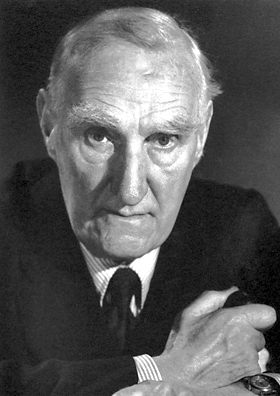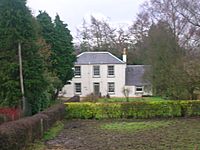John Boyd Orr facts for kids
Quick facts for kids
The Lord Boyd-Orr
|
|
|---|---|
 |
|
| Born |
John Boyd Orr
23 September 1880 Kilmaurs, East Ayrshire, Scotland
|
| Died | 25 June 1971 (aged 90) Edzell, Angus, Scotland
|
| Nationality | Scottish |
| Citizenship | United Kingdom |
| Alma mater | University of Glasgow |
| Known for | wartime nutrition |
| Spouse(s) |
Elizabeth Pearson Callum
(m. 1915) |
| Children |
|
| Awards |
|
| Scientific career | |
| Fields | |
| Institutions |
|
| Academic advisors | E. P. Cathcart |
| Influences |
|
John Boyd Orr, 1st Baron Boyd-Orr (born September 23, 1880 – died June 25, 1971) was a Scottish scientist, doctor, and politician. He is famous for his important research on nutrition. He also helped create the United Nations Food and Agriculture Organization (FAO) and was its first leader.
In 1949, he won the Nobel Peace Prize for his work to improve food and health around the world. He was also a co-founder and the first President of the World Academy of Art and Science.
Contents
Early Life and Education
John Boyd Orr was born in Kilmaurs, Scotland. He was one of seven children. His father, Robert Clark Orr, owned a quarry and was very religious. His mother, Annie Boyd, also came from a family of quarry owners.
John learned to read at a young age from his grandmother. His home had many books, and his family often discussed politics and other big ideas.
When he was five, his family faced financial problems and moved to West Kilbride. He attended the village school there until he was 19. For four of those years, he was a pupil-teacher, meaning he helped teach younger students. This was a busy time, as he also helped with his father's business.
University Studies in Glasgow
At 19, John won a scholarship to study at a teacher training college in Glasgow. This also allowed him to attend the University of Glasgow. He studied subjects like classics, which were part of the Arts course.
He later said that the university work was very demanding. It didn't leave much time to meet and talk with students from different backgrounds.
First Encounters with Poverty
While studying in Glasgow, John explored the city's poor areas. He was shocked by the poverty he saw. Many children had rickets, a disease caused by poor nutrition. Many adults were malnourished, and older people were very poor.
His first teaching job was in a school in these slums. The classrooms were crowded, and the children were hungry, poorly dressed, and sick. He resigned after a few days. He realized he couldn't teach children who were suffering so much. He felt he couldn't do anything to help them there.
After working for his father for a short time, he taught at Kyleshill School in Saltcoats. This area was also poor, but not as bad as Glasgow's slums. To earn more money, he taught an evening class in bookkeeping. The skills he learned from this helped him later in his career.
Return to University for Science
John realized teaching wasn't his true calling. After finishing his teaching duties, he went back to the university. He decided to study biology, a subject he had always loved. He also started studying medicine as a backup plan.
He found the university exciting. He was taught by brilliant scientists like Diarmid Noel Paton and Edward Provan Cathcart. He also admired Samson Gemmell, a professor who thought deeply about social issues.
John ran out of money during his medical studies. He bought some rented apartments with a loan and used the rent money to pay for his education. After graduating, he sold the property for a small profit.
He earned his science degree (BSc) in 1910. He then earned his medical degrees (M.B. Ch.B.) in 1912. In 1914, he received his M.D. with honors, winning a special medal for his research.
Research Career and the Rowett Institute
After university, John worked as a ship's surgeon for a few months. He then worked as a temporary doctor in his hometown. But he soon decided that a career in medicine wasn't for him.
He accepted a research scholarship to work in E. P. Cathcart's lab. There, he began studying malnutrition and how the body uses protein.
Starting the Rowett Research Institute
In 1914, Boyd Orr became the head of a new research institute in Aberdeen. It was meant to study animal nutrition. He quickly realized the budget was too small. He used his business skills to plan a much larger institute.
He started building a strong granite building, even though the committee wanted a cheaper wooden one. He spent the initial money on this, knowing they would have to accept it.
War Service (1914–1918)
When World War I began, John joined the British Army. He first worked on improving hygiene in army camps, preventing many soldiers from getting sick.
Later, he became a medical officer for an infantry unit. He showed great bravery, helping many wounded soldiers. He was awarded the Military Cross and the Distinguished Service Order. He also made sure his soldiers had enough vegetables and proper boots, which kept them healthier than other units.
He then transferred to the Royal Navy, hoping for more time to read and research. His duties were lighter, allowing him to study medical advances.
Expanding the Rowett Research Institute
After the war, in 1919, Boyd Orr returned to Aberdeen. He still wanted to expand the institute. He met John Quiller Rowett, a wealthy businessman. Rowett agreed to donate a large sum of money. The government also agreed to pay half the cost if Boyd Orr could raise the other half.
Rowett's donation came with an important condition: if any animal nutrition research helped human nutrition, the institute could follow up on it. This was a key step in Boyd Orr's work on human health.
By 1922, the buildings were almost finished. The institute was renamed the Rowett Research Institute. John Boyd Orr was very good at raising money from both the government and private donors. He expanded the research farm and built a large library. He also created a center for visiting scientists.
His own research sometimes suffered because he spent so much time fundraising. He later said he resented having to "hunt for money" for the institute.
Through the 1920s, his main research was on animal nutrition. But he soon shifted his focus to human nutrition. He became a strong supporter for better diets for people. In 1927, he showed how important milk was for schoolchildren. This led to free school milk in the UK.
In 1936, he wrote a famous report called "Food, Health and Income." It showed that many people in the UK were too poor to buy enough healthy food. It also linked low income and poor nutrition to children not doing well in school.
International and Political Work
In 1945, Boyd Orr was elected as a Member of Parliament (MP) for the Combined Scottish Universities. He resigned from this role in 1946.
After World War II, he left the Rowett Institute. He took on several new roles, most notably becoming the first Director-General of the United Nations' new Food and Agriculture Organization (FAO). Even though he was only in this position for a short time (1945–1948), he worked hard. He helped deal with the immediate food shortages after the war. He also proposed big plans to improve food production and make sure food was shared fairly around the world.
He suggested creating a World Food Board to help keep food prices stable by storing large amounts of food. This idea didn't get enough support from some countries, but Boyd Orr still built a strong foundation for the FAO.
After leaving the FAO, he became a director for several companies. He was a smart investor and made a lot of money. In 1949, when he received the Nobel Peace Prize, he gave all the prize money to organizations working for world peace and a united world government.
In 1949, he was given the title Baron Boyd-Orr. In 1960, he became the first president of the World Academy of Art and Science. This group was started by leading scientists who were worried about how scientific discoveries, especially nuclear weapons, could be misused.
Personal Life
In 1915, John Boyd Orr married Elizabeth Pearson Callum. They had three children: Elizabeth Joan, Helen Anne, and Donald Noel. Sadly, his son Donald was killed during World War II.
Death and Legacy
John Boyd Orr passed away on June 25, 1971, at the age of 90. He is buried in Stracathro Kirkyard, Scotland.
The University of Glasgow has a building and a research center named after him. His Nobel medal is kept at the university's Hunterian Museum. There are also streets named after him in several towns in Scotland, including his hometown of Kilmaurs.
See also
 In Spanish: John Boyd Orr para niños
In Spanish: John Boyd Orr para niños


